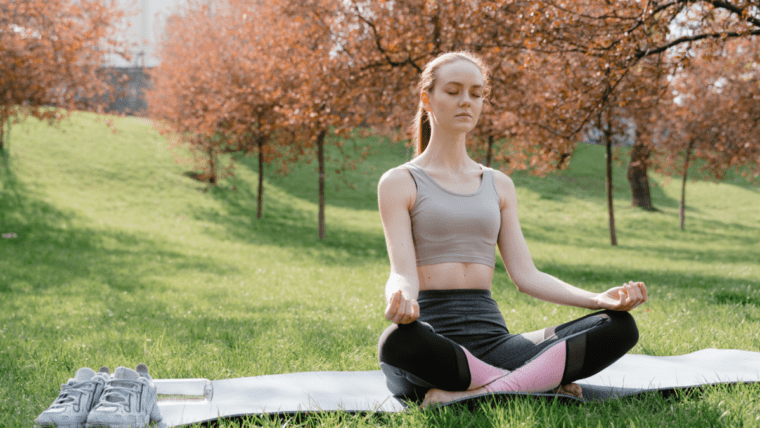We expect more and more of our brains every day. There is a continuous barrage of information available through the internet. Our devices are practically surgically glued to our hands, and there is high uncertainty and confusion in today’s environment. Our brains and our mental well-being are tested like never before. While those things we used to look to for consistency and trust outside of us become more and more questionable, people are starting to realise the need to look inside for the clarity and certainty they require. Meditation for beginners doesn’t have to be a chore.
So, How do you meditate if you are a beginner with a busy mind?
Here are Nine Steps to Meditation for Beginners With Busy Minds.
- Leave your expectations at the door – Meditating is the one place or activity with no expectations to “do” anything or: achieve” a particular state. You may notice yourself expecting things to be a certain way with your meditation; however, you can see these expectations and invite yourself back to your breath, your practice.
- Choose a time when you won’t be disturbed – for some of us, waking up 10 min before everyone in the house wakes up is ideal, while others work well at lunchtime or right before bed, make sure you will not be disturbed.
- Find a comfortable seat – Although you can meditate seated, standing or lying, the seated position allows you to stay awake and alert while relaxing.
- Settle in – allow yourself a minute to adjust and settle into the posture.
- Notice your breath – start to notice your breath; where is the greatest sensation of breath? The tip of your nostrils? Your belly? Your chest? Follow the breath with your attention in and out repeatedly.
- Observe any thoughts that may come up without judgment,
- Gently guide your attention back to your breath.
- Notice what is there for you with a sense of acceptance and friendliness
- Repeat this practice as often as possible
What is Meditation
When most people think of meditation, they picture a bearded man seated in a painful cross-legged position on a mountaintop. That is an example of meditation, however, meditation for beginners doesn’t need to be pretzel-pose torture.
According to Wikipedia, Meditation is a practice where an individual uses a technique – such as mindfulness or focusing the mind on a particular object, thought, or activity – to train attention and awareness and achieve a mentally clear, emotionally calm, and stable state.
Meditation trains the attention to focus on what you choose. Have you ever been caught in a cycle of negative thinking, ruminating about what someone said about you? With a trained mind, you can acknowledge your rumination and gently redirect your attention to something more helpful, like how you are improving in certain areas of your life or simply appreciating the sun on your skin.
“The most important decision we make is whether we believe we live in a friendly or hostile universe.”
Albert Einstein
Scientifically Verified Benefits
For people who are sceptical and consider meditation a waste of time, understanding the scientifically validated evidence for its benefits may motivate them to try it.
Boosts Concentration
Need a solution for that wandering mind that is easily distracted as a puppy? FA, or focused attention meditation, increases your concentration or attention fitness. Meaning you will be able to focus longer and make fewer mistakes when completing tasks. One study found people who listened to a meditation recording had improved attention and made fewer mistakes than those in the control group.
Reduces the impact of aging on the brain
A recent study at UCLA found that those who meditated over a long period (age 20) had more youthful brains (more grey matter volume) than non-meditators as they aged. Grey matter enables individuals to control movement, memory, and emotions, all things we’d like to have to operate at a high level as we age.
Can Lower Blood Pressure
High Blood Pressure puts extra strain on your blood vessels, heart and other organs, such as the brain, kidneys and eyes. Persistent high blood pressure can increase your risk of several severe and potentially life-threatening health conditions like heart attack and stroke.
Twelve studies with just under 1000 participants identified that meditation helped reduce blood pressure. The older volunteers who had higher blood pressure before the study received more significant results
Barriers to Creating a Meditation Practice
Meditation falls into the same type of activity exercise in that we know it would be good for us, BUT we can easily find many excuses for having something better to do. These are the most common barriers to starting a mediation practice and what you can do about them.
Am I doing this right? – This is a common concern; while there are no real rule books on meditation, there are “goals” or things we are “trying” to achieve. As humans, we like to be “good” and get things “right” entering into the world of silence and focus can be daunting. But that is precisely the point; even these questions are just thoughts. By gently returning to your breath and acknowledging these thoughts, you will soon overcome the need for things to be perfect and right.
Motivation – Meditation, for beginners, will seem like the least important thing on your list. You’ll quickly get distracted, and your motivation may wane because you do not see immediate results. That is perfectly normal. Luckily, some great apps and online courses can guide you through the process and help you create the habit of quickly getting into the groove and watching the improvements in your life.
Restlessness – When you sit down for the first time, you’ll probably hear that voice in your head, ugh, this isn’t working; why are we doing this? How long have I been sitting here? UGH! I’m thinking; I’m not supposed to be thinking. This reaction is perfectly normal, and the fact that you notice the voice in your head is the entire point; you are becoming conscious of your thoughts, which is a WIN!
Finding a comfortable position – Going back to the pretzel position we think we’re supposed to sit in. Sitting works well as a position as it combines relaxation with focus. However, standing, lying and walking are all positions for meditation. You can use a cushion to lift your hips if seated cross-legged, making sitting with a tall spine much easier.
Types of Meditation

A Little Slice of Peace
Breath Awareness Meditation
Breath awareness is a mindful meditation that encourages conscious breathing, which involves breathing slowly and deeply while counting breaths. The goal is to focus on your breath and gently ignore or redirect your thoughts. Above all, being gentle is important because trying to stop them will have the opposite effect.
Body Scan
Body scan meditation is a meditation that involves scanning your body and noticing any areas of tension or areas of mobility and ease. The goal is to notice discomfort and to allow it to release. Start with focusing on your feet. Tense and relax each body part, and gradually work your way up to the top of your head. Lying down is the optimal position for this technique; on the other hand, seated or standing works as well. This technique assists with chronic pain and is an excellent pre-bed routing for those who find it difficult to fall asleep.
Mindfulness Meditation
Mindfulness is a form of meditation that is becoming more popular and urges practitioners to remain aware and present in the moment. Therefore, the goal is to notice what is occurring at the moment without judgment. However, instead of focusing on how annoying the traffic is, you note there is traffic without judgment.
Mindfulness meditation is something people can do almost anywhere. For example, while waiting in line at the airport, you might calmly notice your surroundings, including the sights, sounds, and smells you experience.
Are You Ready to Get Mindful? Try this!
Tuning into the sensations of the five senses is a fantastic way to practice mindfulness. Here is a fun and mindful activity you can try.
This activity is called “five senses” and helps you understand how to incorporate mindfulness quickly into nearly any situation. Follow this order to practice the Five Senses:
- Notice five things that you can see.
Look around. What can you see? What can you see that you usually wouldn’t notice? Can you see a beam of light, a shadow, a crack in the wall? Or perhaps you can look at the palm of your hand; what do you notice?
- Notice four things that you can feel.
Start to Bring awareness to four things you feel in the current moment. Can you feel the fabric of your clothes touching your skin? What temperature can you feel? Is there a breeze on your face?
- Notice three things you can hear.
Pause and listen out for three things that you hear in the background. Are there birds chirping? Can you hear the hum of an air conditioner? Are there cars driving by in the distance?
- Notice two things you can smell.
Start to notice what you smell that you usually would go unnoticed. Are they pleasant smells, or are they slightly offensive? Can you smell someone’s lunch cooking? Do you notice the scent of flowers from a nearby garden?
- Notice one thing you can taste.
Take a sip of a drink, even water or chew some gum, or take a bite of food. Focus on one thing that you can taste right now, at this moment. Notice the current taste in your mouth.
This activity is a quick way to get you into a mindful state. Mindfulness allows us to enjoy the enormous benefits of being in the present moment.
Is meditation for beginners worth your time and energy?
The short answer is YES! It’s true that meditation is not the cure for EVERYTHING. However, I can share from personal experience that it has been the most beneficial practice I have undertaken. It has reduced my stress level and increased my capacity to take life as it comes. I can now enjoy the moments ranging from the mundane to the magical. My productivity and ability to find solutions have gone through the roof. In summary, if those benefits sound like something you want in your life, set aside a tiny slice of your day to sit with yourself. Enjoy the benefits of a clearer, happier mind.




1 Comment
Kay
I’m amazed, I have to admit. Seldom do I encounter a blog that’s equally
educative and amusing, andd let me tell you, you have hit the nail
on the head. The issue is something not enough men and womenn are sleaking intelligently about.
I am very happy I stumbled across this in my search for something
relatijng to this.
Comments are closed.